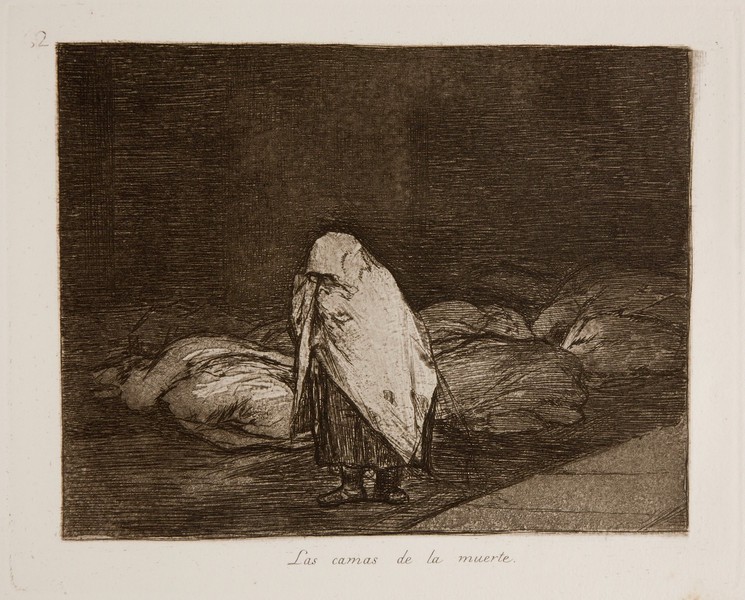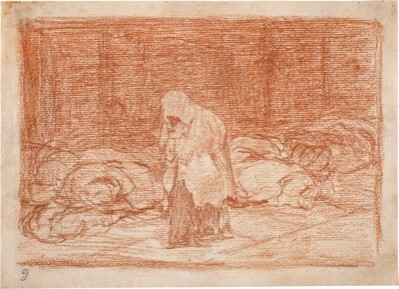- Cronología
- Ca. 1812 - 1815
- Dimensiones
- 177 x 221 mm
- Técnica y soporte
- Aguafuerte, lavis, punta seca, buril y bruñidor
- Reconocimiento de la autoría de Goya
- Undisputed work
- Ficha: realización/revisión
- 20 Dec 2010 / 24 May 2023
- Inventario
- 225
See Sad presentiments of what must come to pass (Tristes presentimientos de lo que ha de acontecer).
The title was handwritten on the print by Goya in the first and only series that is known to have been printed at the time the works were created, which the artist gave to his friend Agustín Ceán Bermúdez. Therefore, the title was etched into the plate at a later date and left unchanged as of the first edition of the Disasters of War printed by the San Fernando Royal Academy of Fine Arts in Madrid in 1863, after the printing of the series in the possession of Ceán Bermúdez.
There is a surviving preparatory drawing for this print which is housed in the Prado Museum in Madrid.
In the middle of a street or another public place a female figure covered from head to foot passes by a group of corpses covered up with sheets. The viewer cannot see the woman's face, although it is clear that she is covering her nose to block out the stench of the bodies.
Goya has made some deep, dense marks in the background, creating a mesh effect in some areas that serves to intensify the darkness. The only light area of the print is the white tunic that completely covers the woman passing by the corpses.
Despite the simplicity of the composition and the fact that the lifeless bodies are depicted covered for the first time in the series The Disasters of War, Goya achieves an intense dramatic atmosphere in this work. The artist does not need to show the mutilated or emaciated, starved bodies in order to evoke a strong sensation of distaste and distress in the viewer. He also reiterates a gesture repeated in print no. 18, Bury them and keep quiet (Enterrar y callar), in which the figures depicted also cover their noses before piles of corpses that are most likely awaiting burial.
The plate is stored in the National Chalcography (cat. 313).
-
Goya and his timesThe Royal Academy of ArtsLondon1963cat. 66cat. 250
-
Francisco de GoyaMuseo d'Arte ModernaLugano1996exhibition celebrated from September 22nd to November 17th.cat. 146
-
Francisco Goya. Sein leben im spiegel der graphik. Fuendetodos 1746-1828 Bordeaux. 1746-1996Galerie KornfeldBern1996from November 21st 1996 to January 1997p. 179, cat. 62
-
Francisco Goya. Capricci, follie e disastri della guerraSan Donato Milanese2000Opere grafiche della Fondazione Antonio Mazzottacat. 142
-
Goya et la modernitéPinacothèque de ParisParís2013from October 11st 2013 to March 16th 2014cat. 101
-
2022
-
Goya, grabadorMadridBlass S.A.1918cat. 164
-
Goya engravings and lithographs, vol. I y II.OxfordBruno Cassirer1964cat. 182
-
Vie et ouvre de Francisco de GoyaParísOffice du livre1970cat. 1098
-
Goya. Arte e condizione umanaNaplesLiguori editore1990lam. 213
-
Catálogo de las estampas de Goya en la Biblioteca NacionalMadridMinisterio de Educación y Cultura, Biblioteca Nacional1996cat. 276
-
Francisco de Goya. Los Desastres de la guerraBarcelonaLa Central2011p. 40
-
ParísPinacoteca de París2013p. 150
-
Goya. In the Norton Simon MuseumPasadenaNorton Simon Museum2016pp. 114-151
-
Museo de Bellas Artes de Badajoz y Diputación de Badajoz2022p. 82

